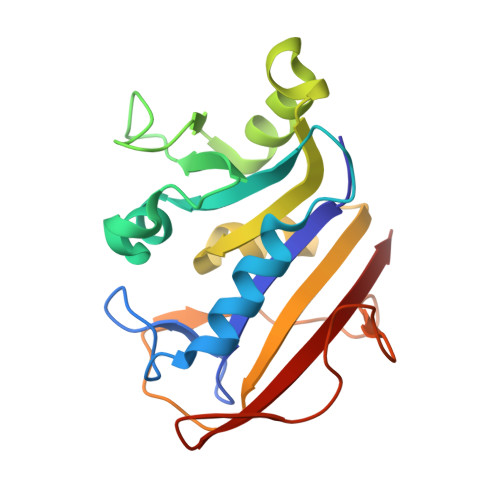Kinetic and structural analysis for potent antifolate inhibition of Pneumocystis jirovecii, Pneumocystis carinii, and human dihydrofolate reductases and their active-site variants.
Cody, V., Pace, J., Queener, S.F., Adair, O.O., Gangjee, A.(2013) Antimicrob Agents Chemother 57: 2669-2677
- PubMed: 23545530
- DOI: https://doi.org/10.1128/AAC.00172-13
- Primary Citation of Related Structures:
3L3R, 3OAF, 4G8Z, 4G95 - PubMed Abstract:
A major concern of immunocompromised patients, in particular those with AIDS, is susceptibility to infection caused by opportunistic pathogens such as Pneumocystis jirovecii, which is a leading cause of pneumonia in immunocompromised patients. We report the first kinetic and structural data for 2,4-diamino-6-[(2',5'-dichloro anilino)methyl]pyrido[2,3-d]pyrimidine (OAAG324), a potent inhibitor of dihydrofolate reductase (DHFR) from P. jirovecii (pjDHFR), and also for trimethoprim (TMP) and methotrexate (MTX) with pjDHFR, Pneumocystis carinii DHFR (pcDHFR), and human DHFR (hDHFR). OAAG324 shows a 9.0-fold selectivity for pjDHFR (Ki, 2.7 nM) compared to its selectivity for hDHFR (Ki, 24.4 nM), whereas there is only a 2.3-fold selectivity for pcDHFR (Ki, 6.3 nM). In order to understand the determinants of inhibitory potency, active-site mutations of pj-, pc-, and hDHFR were explored to make these enzymes more like each other. The most unexpected observations were that the variant pcDHFR forms with K37Q and K37Q/F69N mutations, which made the enzyme more like the human form, also made these enzymes more sensitive to the inhibitory activity of OAAG324, with Ki values of 0.26 and 0.71 nM, respectively. A similar gain in sensitivity was also observed for the hDHFR N64F variant, which showed a lower Ki value (0.58 nM) than native hDHFR, pcDHFR, or pjDHFR. Structural data are reported for complexes of OAAG324 with hDHFR and its Q35K and Q35S/N64F variants and for the complex of the K37S/F69N variant of pcDHFR with TMP. These results provide useful insight into the role of these residues in the optimization of highly selective inhibitors of DHFR against the opportunistic pathogen P. jirovecii.
Organizational Affiliation:
Structural Biology Department, Hauptman Woodward Medical Research Institute, Buffalo, New York, USA.
















